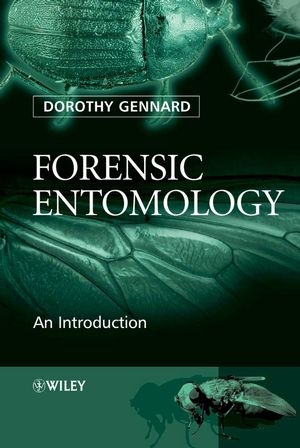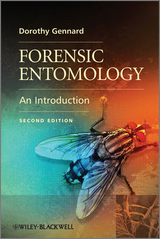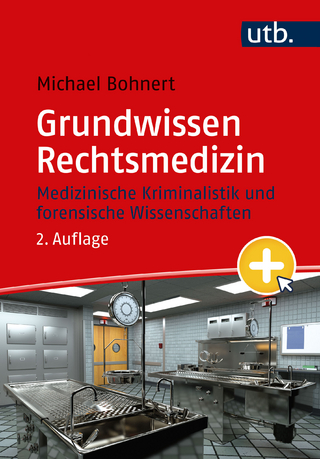
Forensic Entomology
Wiley-Blackwell (Verlag)
978-0-470-01478-3 (ISBN)
- Titel erscheint in neuer Auflage
- Artikel merken
This invaluable text provides a concise introduction to entomology in a forensic context and is also a practical guide to collecting entomological samples at the crime scene. Forensic Entomology: An Introduction: * Assumes no prior knowledge of either entomology or biology * Provides background information about the procedures carried out by the professional forensic entomologist in order to determine key information about post-mortem interval presented by insect evidence * Includes practical tasks and further reading to enhance understanding of the subject and to enable the reader to gain key laboratory skills and a clear understanding of insect life cycles, the identification features of insects, and aspects of their ecology * Glossary, photographs, the style of presentation and numerous illustrations have been designed to assist in the identification of insects associated with the corpse; keys are included to help students make this identification This book is an essential resource for undergraduate Forensic Science and Criminology students and those on conversion postgraduate M.Sc. courses in Forensic Science.
It is also useful for Scenes of Crime Officers undertaking diploma studies and Scene Investigating Officers.
List of figures. List of tables. Preface. Acknowledgements. 1 The breadth of forensic entomology. 1.1 History of forensic entomology. 1.2 Indicators of time of death. 1.3 Stages of decomposition of a body. 1.4 Indicators of physical abuse. 1.5 Insect larvae: a resource for investigating drug consumption. 1.6 Insect contamination of food. 1.7 Further reading. 2 Identifying flies that are important in forensic entomology. 2.1 What is a fly and how do I spot one? 2.2 Forensically important families of flies. 2.3 DNA identification of forensically important fly species. 2.4 Further reading. 3 Identifying beetles that are important in forensic entomology. 3.1 What do beetles look like? 3.2 Features used in identifying forensically important beetle families. 3.3 Identification of beetle families using DNA. 3.4 Further reading. 4 The life cycles of flies and beetles. 4.1 The life stages of the fly. 4.2 The life stages of the beetle. 4.3 The influence of the environment on specific insect species. 4.4 Succession of insect species on the corpse and its role in post mortem estimation. 4.5 Review technique: preparing slides of larval spiracles or mouthparts - preparation of whole slide mounts. 4.6 Further reading. 5 Sampling at the crime scene. 5.1 Entomological equipment needed to sample from a corpse. 5.2 The sampling strategy for eggs. 5.3 Catching adult flying insects at the crime scene. 5.4 Catching adult crawling insects at the crime scene. 5.5 Obtaining meteorological data at the crime scene. 5.6 Review technique: investigating the influence of larval location. 5.7 Further reading. 6 Breeding entomological specimens from the crime scene. 6.1 Returning to the laboratory with the entomological evidence. 6.2 Fly-rearing conditions in the laboratory. 6.3 Conditions for successful rearing to the adult (imago) fly stage. 6.4 Beetle rearing in the laboratory. 6.5 Dietary requirements of insects reared in the laboratory. 6.6 Review technique: preserving and mounting insect specimens. 6.7 Further reading. 7 Calculating the post mortem interval. 7.1 Working out the base temperature. 7.2 Accumulated degree data. 7.3 Calculation of accumulated degree hours (or days) from crime scene data. 7.4 Sources of error. 7.5 Use of larval growth in length to determine post mortem interval (isomegalen and isomorphen diagrams). 7.6 Calculating post mortem interval using succession. 7.7 Review technique: interpretation of data from a crime scene case study. 7.8 Further reading. 8 Ecology of forensically important flies. 8.1 Ecological features of bluebottles (Calliphoridae). 8.2 Greenbottles - Lucilia spp. 8.3 Ecological associations with living organisms. 8.4 Further reading. 9 Ecology of selected forensically important beetles. 9.1 Categories of feeding relationship on a corpse. 9.2 Ecology of carrion beetles (Silphidae). 9.3 Ecology of skin, hide and larder beetles (Dermestidae). 9.4 Ecology of clown beetles (Histeridae). 9.5 Ecology of checkered or bone beetles (Cleridae). 9.6 Ecology of rove beetles (Staphylinidae). 9.7 Ecology of dung beetles (Scarabaeidae). 9.8 Ecology of trogid beetles (Trogidae). 9.9 Ecology of ground beetles (Carabidae). 9.10 Review technique: determination of succession and PMI. 9.11 Further reading. 10 The forensic entomologist in court. 10.1 The Statement of Witness. 10.2 Council for the Registration of Forensic Practitioners. 10.3 Communicating entomological facts in court. 10.4 Physical evidence: its continuity and integrity. 10.5 Review technique: writing a Statement of Witness using the post mortem calculations determined from details given in Chapter 7. 10.6 Further reading. 11 The role of professional associations for forensic entomologists. 11.1 Professional organizations. 11.2 Forensic entomology protocols. 11.3 Areas for future research. 11.4 Further reading. Glossary. References. Appendices. Appendix 1: Form for forensic entomology questions to be asked at the crime scene. Appendix 2: Answers to the calculation of the post mortem interval for the body at the Pleasure Gardens, Wingsea. Appendix 3: UK list of Calliphoridae (2006). Appendix 4: UK checklists for Coleoptera. Appendix 5: List of relevant UK legal acts and orders. Appendix 6: Selected sources of entomological equipment. Appendix 7: Legal information relevant to giving testimony as a forensic entomologist in the USA. Index.
| Erscheint lt. Verlag | 24.4.2007 |
|---|---|
| Verlagsort | Hoboken |
| Sprache | englisch |
| Maße | 175 x 248 mm |
| Gewicht | 634 g |
| Einbandart | gebunden |
| Themenwelt | Studium ► 2. Studienabschnitt (Klinik) ► Rechtsmedizin |
| Naturwissenschaften ► Biologie ► Allgemeines / Lexika | |
| Naturwissenschaften ► Biologie ► Zoologie | |
| Recht / Steuern ► Strafrecht ► Kriminologie | |
| ISBN-10 | 0-470-01478-4 / 0470014784 |
| ISBN-13 | 978-0-470-01478-3 / 9780470014783 |
| Zustand | Neuware |
| Informationen gemäß Produktsicherheitsverordnung (GPSR) | |
| Haben Sie eine Frage zum Produkt? |
aus dem Bereich



